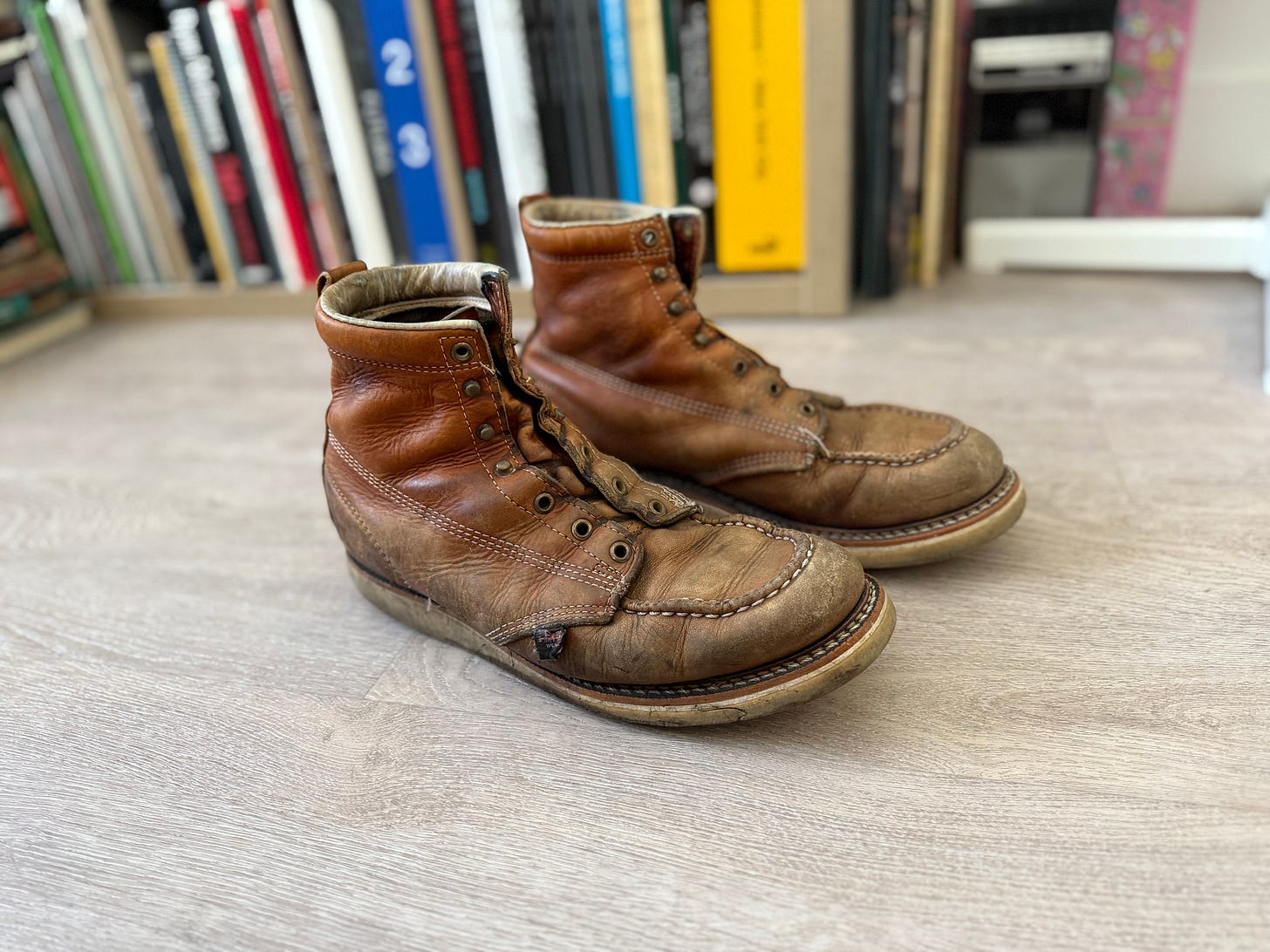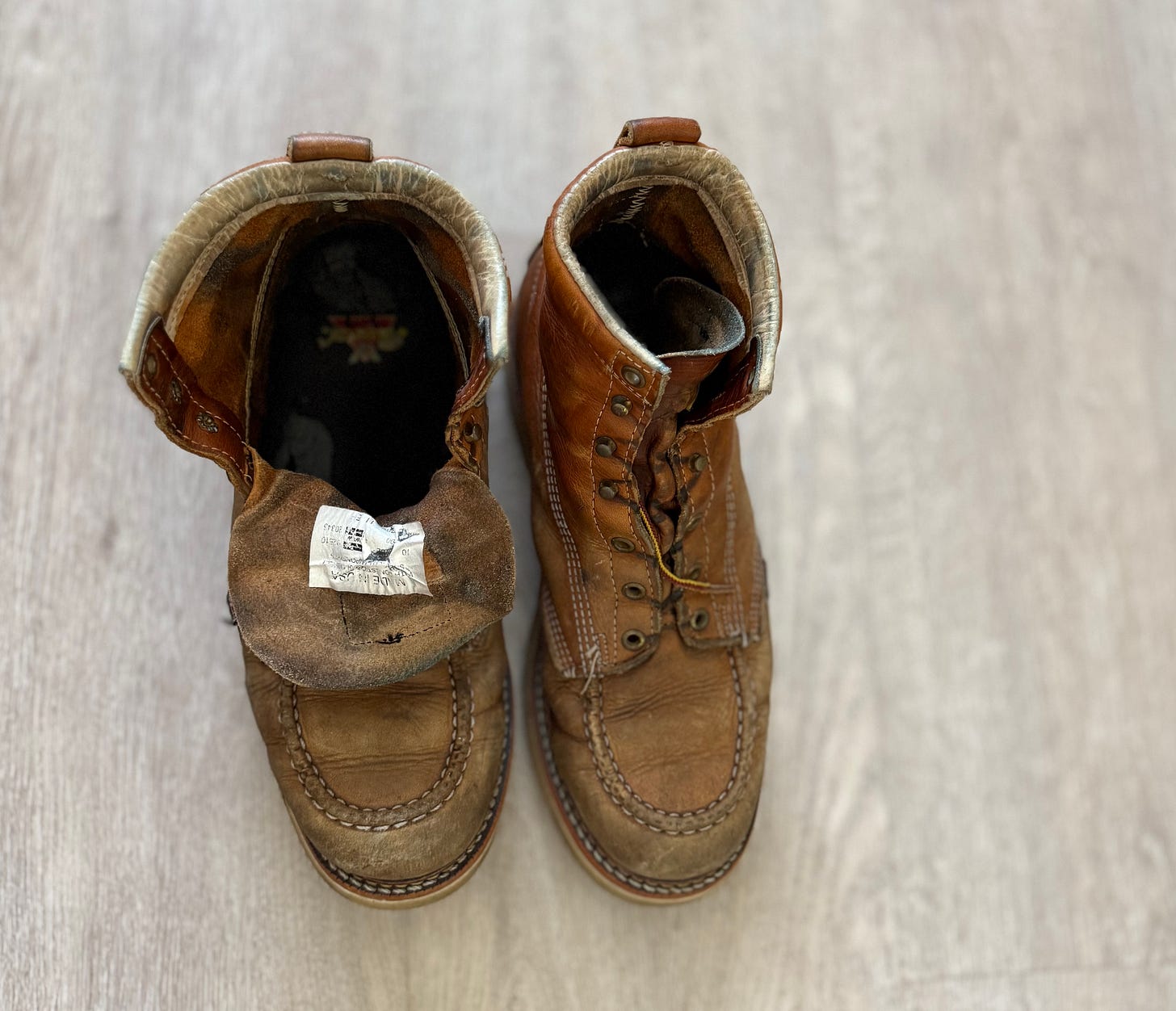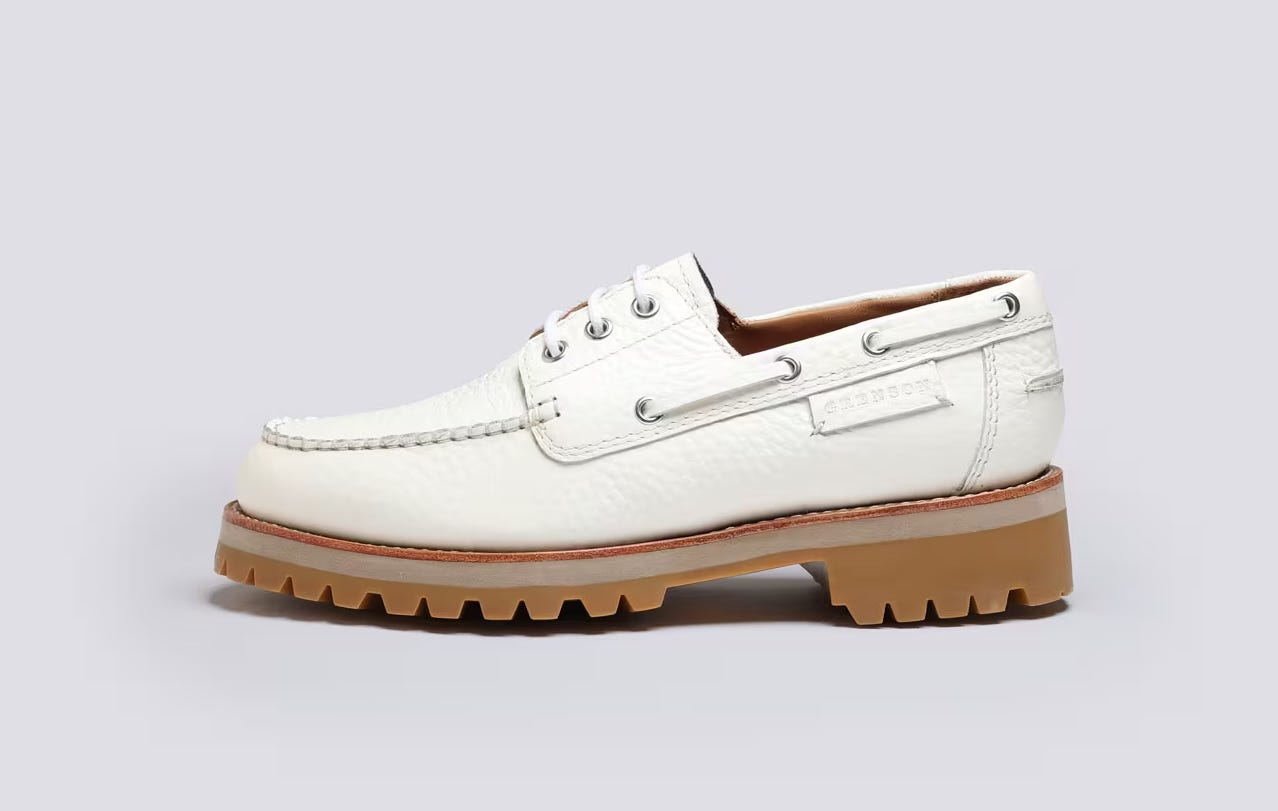Five Things 02
Thorogood Boots, Vintage Camo Vests, Folk Art Handsaws, Grenson, and LL Bean x Wooden Sleepers for Thursday April 17, 2025.
As I write this, I’m looking out over the Pennsylvania side of the Delaware River from my home in Narrowsburg, N.Y. It’s quite the contrast to the day-to-day of Miami where it is never this cold down there. Snd forgive me for calling this weather “cold;” I know it’s a far cry from the frigid temperatures New York experienced earlier in the year.
April in upstate New York is arguably the best time of year, short of early autumn. I can wear more, layer better, and bring out pieces I don’t touch in warmer climates: work boots, quilted liners, etc. I can wear these things because over the last seven years, I’ve stockpiled the closet with American and Canadian-made vintage. At the moment, I’m wearing an ‘80s Non-Fiction mustard crewneck which undoubtedly was made in one of the many fine mills that littered Canada for generation.
This week’s “Five Things” plays into that upstate, rhythm with a selection of well-used objects from the past (and present), each as relevant and usable today as they were when first made. Call them vintage, call them pre-owned—but above all, call them quality. Well-made things deserve to be repaired and made new again, especially when they’re built for repair, like work boots.
That spirit of reuse runs deep in American folk art too—from patchwork quilts sewn from worn-out clothes to oil paintings stretched across the blades of ordinary handsaws.
I hope you enjoy it. —Jeff
Thorogood Six Inch Moc Toe Work Boots
Behold the beauty of a wonderfully worn pair of American-made Thorogood work boots.
This is how work boots should look. I take no credit for what you see here—none at all—for the serious years of hard labor it took to wear these down to their last millimeter of outsole came from an unknown man who’s possession these were once in.
He worked very, very hard. The rocker wear on the sole makes me think they belonged to a laborer, or maybe a foreman, on a job site where lifting and hauling tons of stone was part of the day-to-day. The way the lace lines have molded into the eyelets tells me this guy wore his boots tight to the sock.
Or, which may be the case on these, the boots may have been a little big for him: as one savvy Reddit commenter pointed out, the Thorogood toe box leather is taunt and not stretched. That’s a good sign for one considering a resole on these.
The mark of USA made Thorogood boots is a black American-flag tab on the foot box. Here my example is worn well likely from friction contact with the elements: concrete, dirt and metal.
To some, these Thorogood boots are at the end of their life. It is easier to throw these away and buy another pair, because quite frankly it is. But for a generation that remembers the prominence of shoe repair shops in their hometown,s the mind set is much different.
Today, some of still bring our shoes to our local cobblers or leather repair shops, because well made shoes require service, in the same way your car does. But access to shoe repair shops has dropped drastically. There are less than 3,200 shoe repair businesses remaining in the United States, with COVID causing quite a hit on physical shops, while allowing another to rise. IBISWorld offers the following on the shoe repair industry:
The proliferation of low-cost, disposable footwear from fast fashion retailers and the advent of remote work has significantly affected brick-and-mortar shoe repair shops. Consumers now opt for inexpensive replacements over repairs, driving a decline in traditional repair services. The rise of mail-in repair services has also reshaped the industry.
“Traditional” being the key word in the quote referring to physical walk-in repair shops, and not online nor mail-in repair. Either way you look at it, Americans are repairing fewer and fewer shoes every year.
But maybe the tariffs will be a wake-up call to look at American-made boots again, because we have plenty of good makers active in the United States: Danner, Red Wing, Whites come to mind with Thorogood. Some do make the majority of their stock overseas, but keep the American-made portion of their business, because it matters to many where the things they buy are made.
A new pair of Thorogood 6inch Moc Work Boots are $250 from almost all online shops (Thorogood does not sell direct).
When they finally need new soles say 15 years down the line, you can send them in for a “complete restoration” including new footbeds, midsole and outsole for $130. IMHO, it is well worth it, and both sustainable and American.
Nylon Camo Safety Vest with Canary Applique
Osaka, Japan’s something happens shop is a favorite of mine when chasing warm color inspiration with utilitarian wear nods.
This “Old Nylon” camouflage vest is nothing short of washed-out bliss. The safety orange side—reversible, of course—has mellowed into a muted tone and patina earned through real wear. The kind of aging vintage nerds dream about, and has turned out to be trend in the world of vintage. I, for one, love patina and wear on vintage, because nothing’s perfect once you wear it.
Flip it, and you’ll find an applique of a yellow canary perched on a branch, likely a personal touch that hints at the original owner’s story. The vest’s exact origin is unknown, but my hunch says it’s a gem pulled from the depths of American thrift.
Grenson Dunstan White Boat Shoes
I did not grow up in sneakers. Catholic high schooling was no place for trainers. We needed to wear proper shoes - whatever that meant to our board of directors, who certainly were well intentioned in, well, keeping us uniform.
For that reason, I would dredge annually to Bob’s Surplus more than likely and pick up a pair plan brown boat or camp shoes of the Sebago, Sperry or Eastland - which ever was on sale. By senior year, I was in an upper classmen’s jacket and moved onto Dr. Martens, still likely made in England in the 1990s.1 It was not for a dislike of boat shoe at all that I jumped ship, rather, I just wanted to feel a bit more punk rock and free.
I’ve come in and out of various boat shoes over the years — both traditional and modernized. Back in the early 2000s, Hiroki Nakamura was doing wonders with Burton’s Gravis line (shoutout to the Cue). He eventually moved on to launch Visvim, where he introduced the Hockney, a sneaker that innovated by pairing a moccasin-style upper with a performance outsole.
I’ve been wearing two all-black boat shoes this season: Sperry by Fresh Rags’ Gulfstar A/O 2-Eye, and Sebago Ranger Moc. I love them both equally, but they’re quite different: the Sperry is on a black sawtooth Vibram sole which has a flatter ride and certainly made more for lifestyle and performance, while the Sebago Ranger is traditional lugged camper shoe with girth.
I love Timberland and Japan’s Hender Scheme coming together for an official natural leather lugged shoe with kiltie, doing it only as Hender does it.
But Hender is out of reach of most.
Today, my favorite lugged boat shoe is a white once from Grenson of England.
The Grenson Dunstan is as they say on Instagram: “beefed up.” It features a Goodyear-welted Vibram sole on Grenson’s number 20 last “designed specifically for loafers.” The ride is high and snug, but breaks in like good shoes do. Having owned another Grenson model on the number 20 last, I can say they are rugged and firm.
The white upper makes it for me, with contrasting outsole that allows these to match well under and great trouser or denim.
Grenson’s White Dunstan lugged boat Shoe is $545.
L.L. Bean x Wooden Sleepers Fishing Collection
L.L. Bean’s exposure has been hot. From Made in Maine Bean boots, Bean totes, and L.L. Bean Japan’s two shopping events in New York City and Los Angeles, both of which were well covered by many menswear Substacks (but none closer to the brand that Mordechai Rubenstein), L.L. Bean is top of mind.
It’s part of a bigger marketing play following Bean’s 80th year celebration of the original Original Boat and Tote last year, and continues into 2025 with more curated work by Wooden Sleepers for L.L. Bean.
I asked Wood Sleepers founder Brian Davis about the latest L.L. Bean vintage fishing collection:
I have always been drawn to purpose built clothing that retains its core use, but also can be adopted more broadly. The pieces I have sourced for this collection work just as well in the streams of New England as they do on the streets of Nolita.
Mission accomplished, Wooden Sleepers.
See the full L.L. Bean x Wooden Sleepers Fishing collection online or in store.
American Folk Art Saw-Blade Paintings
Put this one in the category of things I did not expect to find American folk art on. But maybe I should have. Painting on old objects that no longer serve a purpose is a long-standing folk tradition. It’s folk art because someone’s hands took the time to bring detail to the blade of a common hand saw. The painting technique tells me a bit more.
This one has all the hallmarks of rural Americana: a red farmhouse, pumpkins in a patch, a lone scarecrow in a bare field of wheat. I’d guess it was made in the 1960s or ‘70s, though I’m no expert at dating saw blades (if you are, let me know.)
Turns out I’m not the only one fascinated by handsaw folk art, but the art form may be loosing touch with modern tastes.
The last major show I could find on the subject was “Painted Saws: Jacob Kass,” which ran at the American Folk Art Museum’s Eva and Morris Feld Gallery in 2002. A New York Times review of the exhibit included this great anecdote about Kass’ approach, noting how some artists embraced the saw blade as a natural horizontal canvas:
In the hands of another artist, saw painting might have been just a gimmick. Kass brought to the saw well-developed craft skills, and he also responded to the shape of the saw -- as well as to the shapes of other tools like hacksaws and carpenter's squares -- with great formal ingenuity.
My handsaw art is unsigned, so it was likely mass-produced at some point. Still, the nostalgia of an old saw blade painted with a true American landscape makes it undeniably appealing to me.
BTW, here’s a guy on Youtube who uses old hand saw blades to practice his pinstripe work.
Dr. Martens still produces a Made in England line for the specialty market, but the vast majority are produced in Asia.

















Finding your feet with this one, Jeff. Love it.